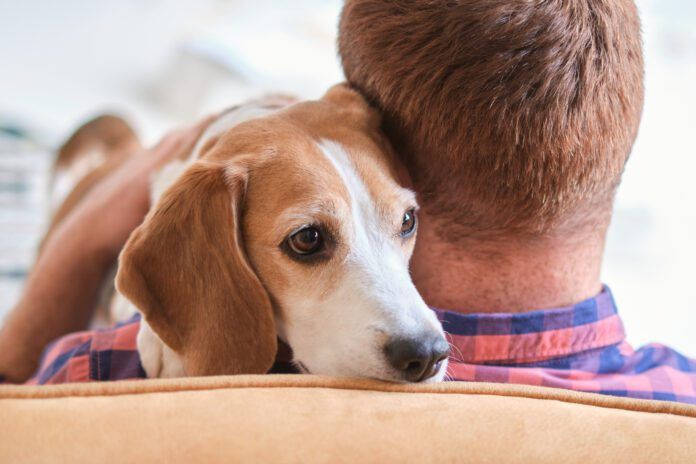Most dog owners don’t need a scientific study to tell them that dogs can pick up on—and be affected by—the emotions of the humans around them. If I’m having a rough day, I can fully expect to find a chin on my knee and big, worried brown eyes gazing up at me. Even if I think I’m hiding my stress well, maintaining a normal routine, and interacting with my dogs as I usually do, the dogs respond.
It makes sense that my dogs would know me well enough to catch on to my emotional state. We live our lives together and I’m their primary handler and caregiver—they’ve had plenty of time to figure out what’s normal for me. But how quickly do dogs pick up on stress in someone they don’t know? Pretty darn quickly from what I’ve seen. Just watch a therapy dog at work.
Beyond my anecdotal observations, canine responses to human stress were documented in a recent study led by the University of Bristol. Published in July 2024, the study found that “dogs experience emotional contagion from the smell of human stress, leading them to make more ‘pessimistic’ choices.”
To determine ‘optimistic’ and ‘pessimistic’ reactions, researchers started by teaching the dogs participating in the study that a food bowl placed in one location always had a treat in it while a bowl placed in another location was always empty. From there, they put bowls in spots between the two original locations and waited to see how quickly the dogs went to go check the new bowls for treats. According to the study, “a quick approach reflected ‘optimism’ about food being present in these ambiguous locations—a marker of a positive emotional state—whilst a slow approach indicated ‘pessimism’ and negative emotion.”
Trials were then done to see how quickly the dogs approached a bowl in an ambiguous location when there were no additional scents present and after the dogs were exposed to “sweat and breath samples from humans in either a stressed (arithmetic test) or relaxed (listening to soundscapes) state.”
Researchers found that dogs exposed to the smell of stressed human were slower to approach ambiguously located bowls, especially those nearer the empty bowl location. The smell of relaxed human seemed to have no effect. Interestingly, the study noted that “the team also found that dogs continued to improve their learning about the presence or absence of food in the two trained bowl locations and that they improved faster when the stress smell was present.”
“Dog owners know how attuned their pets are to their emotions, but here we show that even the odour of a stressed, unfamiliar human affects a dog’s emotional state, perception of rewards, and ability to learn,” says the paper’s lead author, Dr. Nicola Rooney. “Working dog handlers often describe stress travelling down the lead, but we’ve also shown it can also travel through the air.”
While the study’s conclusions didn’t surprise me, I found it to be a good reminder to pay attention to how much stress my dogs may be picking up from me and other people around them. While stress is often unavoidable, it’s worth remembering that, especially if things have been unusually tense for a few days, it may be time for a quiet walk around the neighborhood, gentle brushing, or other calming activity. It’ll be good for dog and human both.







I’m confused. Dogs exposed to stress acted more slowly but also learned faster? It doesn’t sound like exposure to stress is a bad thing- they wanted to learn and learned faster.
“Researchers found that dogs exposed to the smell of stressed human were slower to approach ambiguously located bowls, especially those nearer the empty bowl location. Interestingly, the study noted that “the team also found that dogs continued to improve their learning about the presence or absence of food in the two trained bowl locations and that they improved faster when the stress smell was present.”
I wondered the same thing. It is confusing.
It sounded to me like the study was suggesting that the dogs exposed to the smell of stressed humans were faster to understand the “always has food” and “never has food” locations but were slower to try out the new, unknown locations.
The human example would be something like getting takeout from a restaurant you know has reasonable food and reliable delivery when you’ve had a long, stressful day rather than trying a new place that might be even better but might also be terrible. When stressed, your energy/optimism might not be high enough to risk disappointment on something new but you’re probably more likely to remember the name (and menu) of the place that always gets the food right when you need it.
Thanks for clarifying 🙂
Same for cats. My cat knows when I am stressed. First time I cried in front of her, she licked my feet.
Even when I am mad at the world, I keep the routine of play with her and give her treats. Most times she will take them, sometimes not. We are still figuring out each other as she is inside only.
I had a basset hound that was very attached to me. He also had IBS. One year I was noticed that the week before Thanksgiving all my memories on Facebook were about taking this boy to the vet for vomiting. I realized that I needed to take a step back and really work at being more relaxed around the holiday. I was literally making my poor baby sick! It wasn’t like I was breaking down and crying or getting outwardly upset. He just picked up on the fact that I was trying to bottle up stress.
I’ve had 4 therapy dogs and am so grateful that part of my training as a handler included watching my canine partner for any signs of stress. A memorable moment in a visit to nursing home residents happened as my dog and I were leaving the facility. As I started to pass by a room, I heard a woman crying. She was alone in her room, so I asked if she would like for us to come in. All my dogs had the trained behavior of “go visit”–which meant to place their chin on the person’s lap. Normally it was for about 10 seconds and then they knew they’d get a small treat. This time my high energy, sweet girl placed her head there for petting and chose to leave it there. I didn’t ask her to. She just held that position for about 5 minutes while I spoke with the woman. We stayed for longer, but my dog behaved totally differently than on other visits/other days when she would mostly keep her eyes on me and wait for cues to do tricks for people. That was such a blessing for that lonely woman and a learning experience for me. I miss my therapy dogs!